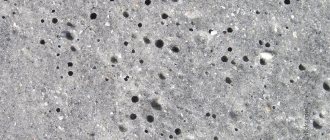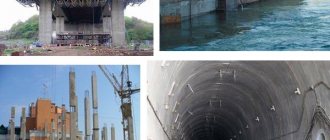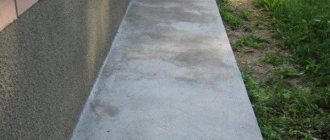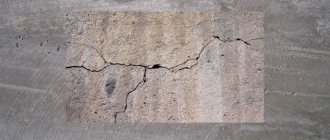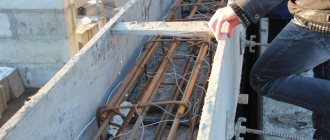The quality, strength and reliability of concrete can only be ensured by following construction technology. Craftsmen use special thermometers for concrete and carry out a number of measurements at different stages of work. Modern devices are compact and lightweight, ergonomic, easy to use. They can be used not only indoors, but also outdoors, in the air, not even at low temperatures. Let's learn more about the specifics of using thermometers, their choice and assortment right now.
Purpose
If the measurements are carried out correctly, the pouring process continues in full compliance with the standards, this will allow compliance with the construction technology. In the future, during the operation of the concrete structure, all sorts of problems will be avoided. The device is used to measure and regularly monitor the temperature of concrete during its heating and pouring.
There will be no cracks or discrepancies in the joints in the concrete. It is not subject to deformation and retains its strict geometric shape for decades. As is known, typical deficiencies of concrete appear precisely because of insufficient quality, non-compliance with technology, and due to deviations from temperature requirements. Models and types of measuring equipment may be different, but the basic rules for measuring with a thermometer remain unchanged.
A new way to control the temperature of monolithic concrete in the ceiling
The article presents a new method for controlling the temperature of monolithic concrete in a ceiling during its curing and a device for its implementation.
Key words: temperature control, concrete curing, overlapping.
The condition of concrete of monolithic structures during curing is usually determined by two parameters that are subject to control and recording: temperature and strength.
Temperature is an indirect indicator of concrete quality, which is subject to mandatory control during electrical heating in winter conditions. There are two main ways to measure temperature during its control when curing monolithic concrete:
1) direct (temperature is measured with a thermometer that is immersed in a well located in the body of the structure);
2) indirect (temperature is measured with an infrared thermometer - pyrometer, the temperature of the formwork surface is measured, after which the temperature of the concrete surface in contact with the formwork is determined by calculation).
Direct measurements for assessing the temperature of concrete in the floor are characterized by low technology: to be able to carry out measurements, it is necessary to provide regular wells in the body of the structure, working platforms for moving along the hardening floor, etc. Therefore, this method of measuring temperature cannot be recommended for mass use when monitoring the hardening process concrete in building floors.
Currently, a method for controlling the temperature of concrete, described in a number of technological recommendations for winter concreting, for example [1], as well as in a dissertation research [2], has become widespread. This method is implemented as follows. At the site of the planned concrete temperature measurements, the air temperature is determined. Next, using a pyrometer, determine the temperature of the outer surface of the inventory or permanent floor formwork. Then, using the known calculated dependencies [3, 4], the temperature of the cured monolithic concrete along the surface of its contact with the formwork is calculated.
The results of the practical application of this method showed that it does not provide high accuracy in measuring the temperature of the formwork and, as a consequence, the temperature of concrete, for the following reasons:
– there are no measures to prepare the surface of the formwork for measuring its surface temperature with an infrared thermometer;
– there are no measures to take into account the speed and direction of the wind blowing the formwork when measuring the temperature of its surface;
To eliminate these shortcomings, we have developed a new method for monitoring the temperature of monolithic concrete in the ceiling, as well as a device for its implementation, which provide high accuracy in measuring the temperature of the formwork.
The developed device, designed to eliminate the influence of wind when measuring temperature, is a hollow truncated cone, for example made of tin, with a handle holder (figure). Support protrusions are made along the larger base of the cone. The height of the truncated cone is at least 50 cm, and the height of the supporting protrusions does not exceed 1 cm; the internal diameter of the larger base of the truncated cone is at least 60 cm, and the internal diameter of its smaller base is at least 50 cm.
Rice. 1. Device for implementing a method for controlling the temperature of concrete: 1 - hollow truncated cone; 2 — supporting protrusions; 3 — handle holder
The proposed method is implemented as follows. At the site of monitoring the temperature of the floor concrete, the air temperature is measured at a certain frequency established by technological regulations or the project, for example, with an electronic thermometer. Next, a section of the outer surface of the floor formwork (inventory or permanent), selected to determine the temperature of monolithic concrete along the surface of its contact with the deck, is cleaned of layers of dirt, adhering concrete or cement laitance. Then the developed device is pressed against the cleaned surface with supporting protrusions, so that the geometric centers of the cleaned surface of the formwork and the larger base of the device coincide with each other. The device is held in this position using a handle-holder for at least one minute, while using an infrared thermometer, the temperature of the formwork surface is determined at least twice in a row. The surface area for which the temperature is determined must be limited to the area of the larger base of the device. The obtained measurement results are compared to assess their reliability, and if necessary, the arithmetic mean of the results is found. The temperature of the cured monolithic concrete along the surface of its contact with the deck is calculated using the known calculated dependencies between the temperature of the outer surface of the formwork and the temperature of the concrete along the surface of its contact with the deck, while the wind speed, which is recommended to be taken into account in the design dependencies, is taken to be zero.
High accuracy of formwork surface temperature measurements, according to the method, is achieved as follows.
1. Elimination of measurement errors that arise when the wind blows over the surface of the formwork or, on the contrary, when air masses stagnate. When using the developed device, the surface of the formwork on which the temperature is measured is protected from the wind, but this eliminates the possibility of aerostasis (air stagnation) surrounding this formwork surface due to the presence of gaps between the supporting protrusions;
2. Providing the ability to verify the reliability of the obtained duplicate measurements. The method provides for comparing the obtained data and, if necessary, calculating their arithmetic mean.
3. Ensuring consistency between the optical resolution of the pyrometer and the internal diameters of the device bases. The dimensions of the device are determined in such a way that when measuring the temperature of the formwork surface with a pyrometer, the spot of the measured surface is located inside the circle formed by the base of the device.
As noted above, to calculate the temperature of cured monolithic concrete along the surface of its contact with the formwork, it is necessary to determine the following parameters:
– formwork surface temperature — tп, ºС;
– outside air temperature — tn.v., ºС.
In addition to these values, which change during the process of controlling the temperature of the concrete, it is also necessary to determine the thermal resistance of the formwork structure R, m2·ºС/W. For plywood formwork with a thickness of 21 mm, thermal resistance R = 0.017 m2·ºС/W.
The complete formula for determining the temperature of concrete, based on the stationary Fourier equation of thermal conductivity of the first kind, is as follows:
,(1)
where σ = 5.67 10–8 Wm-2K-4—Stefan-Boltzmann constant;
ε is the degree of emissivity of the total normal radiation of the fencing material (formwork), for wooden formwork ε = 0.85;
k is the convective component of the air heat transfer coefficient, depending on the wind speed; in the case of using the proposed method and device, the wind speed should be considered zero, therefore k = 3.77 W/m2°C.
Using the data presented in [1 and 4], formula (1) can be simplified to the following form:
.(2)
Thus, when using the proposed method, the temperature of concrete can be determined with high accuracy using formula (2), adapted for calculations on a construction site.
The proposed method for monitoring the temperature of monolithic concrete in a ceiling will make it possible to carry out temperature measurements with high accuracy and, as a result, improve the quality of the process of monitoring the strength gain of concrete of load-bearing structures.
An application for a RF patent for an invention has been filed for the method and device for its implementation presented in the article, which is currently undergoing examination at FIPS.
Literature:
1. R-NP SRO SSK-02–2015 Recommendations for the production of concrete work in winter. NP SRO "Union of Construction Companies of the Urals and Siberia." Chelyabinsk, 2015. - 84 p.
2. Zinevich, L.V. Development of technology for operational temperature-strength control of concrete when curing monolithic structures in the conditions of modern high-speed construction: dissertation... k-ta tekhn. Sciences: 05.23.08 / Zinevich Lyudmila Vladimirovna - Moscow, 2009. - 200 p.
3. Guide to heating concrete in monolithic structures / ed. B. A. Krylova et al. M.: NIIZhB, 2005. - 275 p.
4. Golovnev, S. G. Optimization of winter concreting methods / S. G. Golovnev. L.: Stroyizdat, 1983. - 235 p.
Types of devices, brands
Let's find out what types of devices there are.
- Infrared can take measurements at a distance.
- Wireless controlled from a distance.
- Complete devices can measure indicators in two containers at once.
- Bimetallic models have long probes. This meter needle is convenient to use when taking measurements.
- Models for heating the concrete mixture are used in the cold season.
Let's consider the most reliable, functional thermometers, main brands, models. They have managed to earn not only popularity among ordinary consumers, but also the trust of experts.
- The optimal level of quality and almost flawless measurements are distinguished by the German brands Testo, Omron, Festo. These devices operate virtually without failure and provide high accuracy. At the same time, a wide range of models is produced, different price categories are presented. You won’t find budget options at the lowest cost here, but the investment will be completely justified. In addition, you can easily select a device taking into account all the details, purpose and conditions of use.
- Testo 905-t2. Famous model for surface temperature measurement of concrete. When the surface is uneven, this type of device will become truly indispensable. There is a convenient automatic connection option. At the same time, experts note that working with such a device is very convenient: it is reliable, the error is minimized to one percent.
- Testo 905-t1. This model is already submersible. The device provides maximum measurement speed. The range for qualitative temperature determination is wide: it starts at 55 degrees below zero, and the upper limit is 350 degrees. It will only take two minutes to complete the measurements. The error will be a maximum of a degree.
- A worthy domestic model is “Minizamer-D”. The thermometer is a small device with a long steel probe. For easy use, it has an additional pointed end. In addition, you can additionally order a scoreboard. It is mounted perpendicular to the temperature sensor. The error here is in the range of 0.5 – 1.0 degrees.
In Russia, thermometers for concrete are also produced by the industrial enterprises Zamer, Stroypribor, and Ekoproektservis. Their equipment also enjoys the trust of craftsmen and experts and performs well in practice.
Types of thermometers and main characteristics
During the production of concrete, it is necessary to monitor its temperature at each stage of creation in order to obtain the required brand quality. For this purpose, special devices are used - technical thermometers:
- Wireless. It is controlled via the Internet, which makes it very convenient to use. It determines, in addition to temperature, density, after which it transmits the data to the computer. When using the device, it is possible to be absent from the area being tested, which saves time on the regulatory process.
- Infrared thermometer. A distinctive feature is remote metering. The device registers these radiations using a photographic or photoelectric method.
- Thermometer for heating concrete. To preserve the properties of concrete, the device is used in the winter, when the mixture needs to be heated.
- Complete. The device has a set of devices that allows you to measure temperature in two containers simultaneously. The thermometer also has a wire ten meters long and two sensors, one of which is lowered into the concrete mixture, and the other is mounted on the formwork. The advantage of the device is its durability and a very bright indicator.
- Bimetallic. It has meter-long probes in the form of needles and is used both in construction and for other economic purposes.
As a rule, a concrete temperature meter is used in a factory or when it is necessary to make a certain grade. In this case, a heating device must be used; it is connected to a stove or to another device that increases the temperature.
Using the thermometer correctly: recommendations for use
Masters with extensive experience have already worked out every nuance when using such special thermometers for concrete. It is very important to act correctly and follow the algorithm in order to obtain reliable results.
Let's consider the correct procedure for measuring concrete with a thermometer. Let's find out just five basic requirements.
- First of all, you need to make sure that a specific model of the device will actually be convenient, optimal during operation, and will reduce the risk of error. Experts do not advise choosing a thermometer based only on savings or a small budget. The quality of the concrete, and ultimately the entire structure, directly depends on the thermometer and its use. It is necessary to find a modern device, easy to use, which will ensure the simplicity of conducting research on the technical properties of concrete. Of course, a master can handle a complex device, but a beginner needs a model that is easy to operate.
- When you start measuring temperature, the best option is to take readings several times, and then come up with the arithmetic average. This is done by a fairly simple action: all the numbers are added up, and then divided by the number of dimensions.
- A good option is models with device memory. They will be able to record the received data without any problems. Very convenient for those who work with a thermometer on a regular basis. Having stored the data in memory, you can easily restore it, even if the table was not consolidated, it was accidentally lost.
- Another good solution from construction professionals. All measurements are accurately recorded and then tabulated. This approach will help to properly control the temperature of the concrete mixture. As a result, there is every reason to create a reliable, strong and durable concrete structure.
- Remember the units of measurement! After all, not only the Celsius scale works, but also the Fahrenheit scale. For people in the twenty-first century, the Celsius scale is still familiar, although masters freely translate the indicators to Fahrenheit.
Try to act wisely to get reliable results. To comply with the technology features, it is important to minimize the error.
Thermometers for monitoring concrete temperature
The quality, strength and reliability of concrete can only be ensured by following construction technology. Craftsmen use special thermometers for concrete and carry out a number of measurements at different stages of work. Modern devices are compact and lightweight, ergonomic, easy to use. They can be used not only indoors, but also outdoors, in the air, not even at low temperatures. Let's learn more about the specifics of using thermometers, their choice and assortment right now.
Tips for choosing
Here are the factors to consider when choosing a model:
- type of power supply (is there an offline mode);
- ease of operation;
- units of measurement;
- service life;
- Terms of Use;
- availability of a long warranty period.
Experts give the following advice: when choosing a specific model, you need to focus not only on the cost and set of options. It is important to understand how broad functionality will be required to solve specific problems, how often the device will be used, and what experience the technician has.

